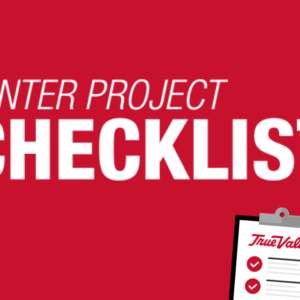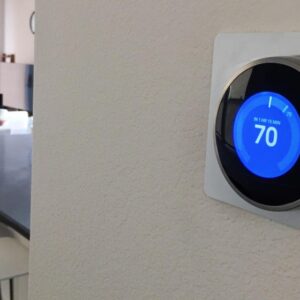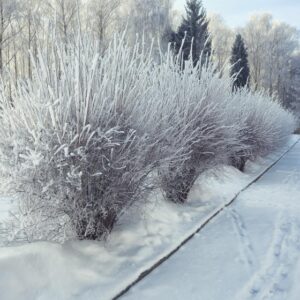Turning your home into a “Winter Wonderland” this holiday season is simple. This project will help you choose natural holiday décor, as well as show you how to use indoor and outdoor lighting that will dress up your home for the holidays.
Decorate with Natural Decor
Using seasonal holiday decorations made of natural materials can add a fun and festive atmosphere to your indoors and outdoors, not to mention their Earth- and budget-friendliness.
Collect materials with which to make your decorations year-round—collect spruce and other evergreen clippings when you trim your outside foliage. When you’re outside on a walk, look for dried flowers and other vegetation like nuts, berries and pinecones. The change in seasons will provide a plethora of textures and colors. The more you think ahead, the better stockpile you’ll have to make Christmas decorations.
Try some of these tips on how to decorate with good cheer the natural way.
Step 1: Make Your Own Wreath
Design your own custom wreath. Gather trimmings from your yard or from your new Christmas tree. Cedar, pine and fir provide great materials for wreath greenery. The tips of these boughs work best. Collect a couple of handfuls of holly or similar berries with leaves for added effect.
Create a frame for the wreath using a standard wire coat hanger; bend it into a circle—you can use its hook to hang the wreath when it’s completed. Bunch a handful of trimmings together with all the stems at one end and attach them to the coat hanger frame with floral wire. The floral wire should be wrapped around the frame as you go along connecting the bundle of clippings to the frame. Wrap the wire around the bundles a second time and be sure it is pulled tight and that each successive bundle covers the clippings’ stems. When all bundles have been attached, twist the wire around the last bundle and knot it onto the frame. Trim excess wire with wire cutters.
Use floral wire or a glue gun to attach the holly bundles or some pinecones to the frame the same way.
Step 2: Make Natural Garland
Make your own garland. Garland is great for decorating stairs, banisters, and mantels and anywhere else you think it looks appropriate and attractive. Like wreaths, evergreen branches are perfect for making garland. If you don’t have enough from clippings to work with, you can also find them at garden centers (you will need branches that are about 12″ long).
Trim or shake off dead or loose needles. Place one branch on top of another and be sure that there is no gap between sections of needles. Use floral wire to fasten the two branches together by wrapping the wire around them three or four times. Continue to do this with your other branches—fasten each section together by wrapping them with the wire and tying the wire off tightly.
Attach some holly or pinecones using a hot glue gun. Make sure that you press these additions down firmly and hold them for a couple of minutes until the glue sets.
Step 3: Go Beyond the Poinsettia

The Holiday Cacti or Cyclamen are great alternatives to the traditional poinsettia. These plants offer colorful holiday blooms; plus you can enjoy them year-round.
The Holiday Cactus, also known as the Thanksgiving Cactus (Schlumbergera truncata) or the Christmas Cactus (Schlumbergera), can be bought during the holiday season already in bloom. It should sit in indirect sunlight in regular indoor temperatures. Keep the soil moist and fertilize weekly.
To get last year’s cactus to bloom, leave it at night at temperatures around 55 degrees while the plant is beginning to flower. If you can’t store them at that temperature, don’t worry. The cactus will flower with 12 to 13 hours of darkness each night. One trick is to lay black plastic over the plant when the lights are on.
Cyclamen (available in white, red and deep pink) generally lay dormant during summer months and bloom indoors during winter.
Great job! Your home is now bedecked with holiday charm inside and out.
Hang Outdoor Christmas Lights
You’ll find a variety of bright and merry holiday lights for outdoor decoration at your local True Value hardware store. There are string icicle lights for roof edges, net lights for bushes, colored floodlights and rope lights for railings, porches, trees and around doors and windows.
Here are the basics on how to decorate your house with Christmas lights.
Step 1: Plan Your Lighting
Make a dimensioned sketch of the area of the house you’ll be lighting. With the house sketch and list of available supplies at hand, devise a plan for lights and write up a shopping list.
Step 2: Provide Safe Power
Power your lights safely and responsibly. Buy a 16-gauge extension cord with an in-line circuit breaker and multi-outlet plug, if you’re stringing many lights. You may need additional standard 16-gauge cords. “Landscape” cords are colored green to make them less visible in the grass and shrubs. Wrap all connections with electrical tape and/or cover them with a plastic bag taped to the cords to seal the ends.
If you have an outdoor outlet that has covers that snap over the unused receptacles, replace the cover with a larger “in-use” type, which will protect the receptacle from the weather when it is in use. Also make sure that the receptacle is a GFCI (ground-fault circuit interrupter) type.
Step 3: String Lights on Your House
Use string lights, regular or icicle-style, to outline the architectural lines of your house. Slip universal-style clips under sidewall siding or the shingles at gable roof edges and snap the wires or lamps into the clips. Use gutter clips or S-hooks to hang strings of lights to the front edge of gutters.
Step 4: Place Lights on Trees and Shrubs
Cover your trees and shrubs with holiday lights. Rather than trying to twist and wrap wires around the branches, use reusable clips and/or various sizes of plastic cable ties.
Light mats, which are web-like arrangements of evenly spaced lights, work well over manicured shrubs such as yews. Center the mat at the top front edge so any open or overlapped areas will be in the back of the shrub.
SAFETY ALERTS!
Only use lights designated specifically for outdoor use.
When hanging lights, stay clear of power lines.
If connecting to an inside power source, keep the window or door open slightly so the cord does not get crushed.
Hang Indoor Christmas Lights
Add lights to your Christmas tree by working from the inside (close to the tree trunk) out towards the tips of the branches. When you reach the tip of a branch, wrap your way back toward the trunk.
Mini lights and C7 Christmas lights are typically used to decorate indoor trees. Ask your local experts at True Value for assistance in choosing the right bulbs for your tree.
Use Christmas lights throughout your home (such as rope lights and mini-lights) along doorways, windows, stair railings and mantels to add a festive look to your rooms.
SAFETY ALERTS!
Unplug all Christmas lights before leaving home or going to bed.
Avoid overloading electrical outlets or extension cords.
Keep all cords out of the way in high-traffic areas in your home.
Project Shopping List
Here’s what you’ll need to complete this project successfully.
- Christmas tree
- Measuring tape
- Handsaw
- Twine
- Blanket
- Gloves
- Wire coat hanger
- Floral wire
- Wire cutters
- Glue gun
- Evergreen branches
- String lights
- Net lights
- Colored floodlights
- Rope lights
- 16-gauge extension cord with circuit breaker and multi-outlet plug
- Plastic electrical tape
- Plastic bag
- GFCI outlet
- Universal-style clips
- Gutter clips
- S-Hooks
- Plastic cable ties (if needed)
- Mini lights or C7 lights












